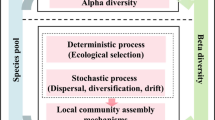Abstract
Picea sitchensis and Pseudotsuga menziesii seedlings were grown in containers, inoculated with ectomycorrhizal fungi, and planted in British forestry sites. Root samples taken during the year after planting were assessed for mycorrhiza formation. Survival and shoot height were assessed at the end of each year. Observations were made each autumn on the occurrence of sporophores of ectomycorrhizal fungi. Pot experiments were used to assess the colonization potential of soils from the experimental locations. Assessment of mycorrhiza formation by the inoculant fungi both before planting and the following year showed much variation among the fungi used. Similar variation was found among field sites. Inoculation with Laccaria isolates was most successful. Height measurements are reported for the first 2 years after planting, at which time there were few significant effects on growth of Picea sitchensis or Pseudotsuga menziesii seedlings. Experimental assessment of colonization potential was of little value in this work for predicting events in the forest.
Similar content being viewed by others
References
Aldhous JR (1972) Nursery practice. (Forestry Commission Bulletin 43) Her Majesty's Stationery Office, London
Holden JM, Thomas GW, Jackson RM (1983) Effect of mycorrhizal inocula on the growth of Sitka spruce seedlings in different soils. Plant Soil 71:313–317
Ingleby K, Mason PA, Last FT, Fleming LV (1990) Identification of ectomycorrhizas. Her Majesty's Stationery Office, London
Kropácek K, Cudlin P, Mejstrik V (1989) The use of granulated ectomycorrhizal inoculum for reforestation of deteriorated regions. Agric Ecosyst Environ 28:263–269
Lamb RJ, Richards BN (1971) The effects of mycorrhizal fungi in the growth and nutrient status of Slash and Radiata pine seedlings. Aust For 35:1–7
Last FT, Wilson J, Mason PA (1989) Numbers of mycorrhizas and the growth of Picea sitchensis — what is the relationship? Agric Ecosyst Environ 28:293–298
Le Tacon F, Garbaye J, Bouchard D, Chevalier G, Olivier JM, Guimberteau J, Poitou N, Frochot H (1988) Field results from ectomycorrhizal inoculation in France. In: Lalonde M, Piche Y (eds) Canadian Workshop on Mycorrhizae in Forestry. Université Laval, Quebec, pp 51–74
Le Tacon F, Alvarez IF, Bouchard D, Henrion B, Jackson RM, Luff S, Parlade JI, Pera J, Stenström E, Villeneuve N, Walker C (1993) Variations in field response of forest trees to nursery ectomycorrhizal inoculation in Europe. In: Read DJ, Lewis DH, Fitter AH, Alexander IJ (eds) Mycorrhizas in ecosystems. CAB International, Wallingford, UK, pp 119–134
Marx DH (1969) The influence of ectotrophic mycorrhizal fungi on the resistance of pine roots to pathogenic infection. I. Antagonism of mycorrhizal fungi to root pathogenic fungi and soil bacteria. Phytopathology 59:153–163
Marx DH, Kenney DS (1982) Production of ectomycorrhizal fungus inoculum. In: Schenck NC (ed) Methods and principles of mycorrhizal research. American Phytopathology Society, St Paul, Minn, pp 131–146
Marx DH, Cordell CE, Kenney DS, Mexal JG, Artman JD, Riffle JW, Molina RJ (1984) Commercial vegetative inoculum of Pisolithus tinctorius and inoculation techniques for development of ectomycorrhizae on bare-root tree seedlings. For Sci 30 [Suppl]:1–101
Marx DH, Cordell CE, Clark A III (1988) Eight-year performance of Loblolly pine with Pisolithus ectomycorrhizae on a good quality forest site. S J Appl For 12:275–280
Marx DH, Cordell CE, Maul SB, Ruehle JJ (1989a) Ectomycorrhizal development on pine by Pisolithus tinctorius in bare-root and container seedling nurseries. New For 3:45–56
Marx DH, Maul SB, Cordell CE (1989b) Application of specific mycorrhizal fungi in world forestry. In: Leatham GF (ed) Frontiers in industrial mycology. Chapman & Hall, London, pp 78–98
Mikola P (1989) The role of ectomycorrhiza in forest nurseries. Agric Ecosyst Environ 28:343–350
Mortier F, Le Tacon F, Garbaye J (1989) Effect of dose and formulation of Laccaria laccata inoculum on mycorrhizal infection and growth of Douglas fir in a nursery. Agric Ecosyst Environ 28:351–354
Moser M (1958) Die künstliche Mycorrhizaimpfung an Forstpflanzen. III. Die Impfmethodik im Forstgarten. Forstwiss Zentralbl 78:193–202
Perrin R, Duvert P, Plenchette C (1988) Substrate receptiveness to mycorrhizal association: concepts, methods and applications. Acta Hortic 221:223–228
Shaw CG, Jackson RM, Thomas GW (1987) Fertilizer levels and fungal strain influence the development of ectomycorrhizae on Sitka spruce seedlings. New For 3:215–223
Stenström E, Ek M, Unestam T (1986) Problems in taxonomy of mycorrhizal fungi. Prolonged effects of initially introduced mycorrhizae of pine plants after outplanting. In: GianinazziPearson V, Gianinazzi S (eds) Physiological and genetical aspects of mycorrhizae. INRA, Paris, pp 503–506
Thomas GW, Jackson RM (1983) Growth responses of Sitka spruce seedlings to mycorrhizal inoculation. New Phytol 98:223–229
Walker C (1986) Mycorrhizas. (Forestry Commission Report on Forest Research 1985) Her Majesty's stationery Office, London, pp 33–34
Wilson J, Mason PA, Last FT, Ingelby K, Munro RC (1986) Ectomycorrhiza formation and growth of Sitka spruce seedlings at first rotation forest sites in Northern Britain. Can J For Res 17:957–963
Author information
Authors and Affiliations
Rights and permissions
About this article
Cite this article
Jackson, R.M., Luff, S., Walker, C. et al. Inoculation and field testing of Sitka spruce and Douglas fir with ectomycorrhizal fungi in the United Kingdom. Mycorrhiza 5, 165–173 (1995). https://doi.org/10.1007/BF00203333
Issue Date:
DOI: https://doi.org/10.1007/BF00203333




